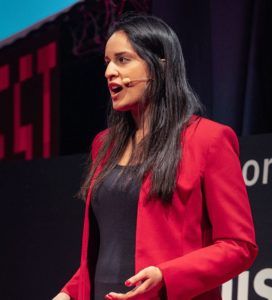I’ve been following Nandini Jammi’s truth-affirming work at Sleeping Giants for the last four years, which is suddenly now in the mainstream with support of like-minded social action organizations and a rebellion of Facebook advertisers. With her co-founder Claire Atkin, she has just launched a for-profit company [Check My Ads] to help advertisers audit their online placements as well as improve marketing efficiency. This issue is central to many recent tech/product conversations, so I’ve stepped out of my normal first-person writing to share this interview.
[Rich Mironov]:
First, tell me the Sleeping Giants origin story and mission…
[Nandini Jammi]:
Sleeping Giants is a social media campaign dedicated to making bigotry and hate unprofitable. We started in November 2016, after the elections, by posting screenshots of ads we found on Breitbart on social media. We were trying to make companies aware that their ads were funding hate speech and white supremacist rhetoric.

For me, the journey started when I visited that website for the first time – I had been hearing about it through the 2016 elections – and saw an ad for Old Navy. I thought, “What is an Old Navy ad doing on Breitbart?” I tweeted at the company and then I wrote a Medium article to try to get marketers on top of it. I urged them to go into their Google Ads and add Breitbart.com to their exclusion list so their ads would not appear there anymore and they would no longer send that outlet their ad dollars. One day later, I joined forces with someone else who had the same idea. We began working together, refreshing Breitbart.com dozens of times a day, to see what brands we could find and notify them on social media. It quickly turned into a big crowdsourced effort, because it was so simple anyone could join us. Of course, everyone was seeing different ads because of the way retargeting works, and that way we were able to scale our efforts. Today, over 4,000 advertisers have confirmed that they’ve excluded Breitbart from their media buy.
In 2017, we began using the same tactics to target Bill O’Reilly and Tucker Carlson’s advertisers.
We have also targeted tech platforms, payment processors, email marketing software and ecommerce stores for enabling and monetizing white supremacists and Nazis.
Last fall, I met an adtech expert who approached me to tell me he was amazed at what we’d done at Sleeping Giants with Breitbart, but challenged me to think about how many other Breitbarts could be out there. If there was one, couldn’t there be hundreds or thousands more? He helped frame my thinking more broadly than “what website should we target next?” I hadn’t really thought about how the entire system facilitates hate speech, disinformation, fake news. I had just been looking at the tip of the iceberg. I decided that this couldn’t just be a part time job or volunteer effort for me anymore. If I’m going to fix this, I have to do it full-time. So I just made the decision to call myself a brand safety advocate.

Check My Ads cofounder Claire Atkin and I started researching the industry together. We started mapping out the entire tech ecosystem, not just learning about the tech itself, but also the relationships and the systems that are in place that perpetuate this broken system. We learned that every player in the advertising supply chain is profiting from this fraudulent, wasteful and opaque ecosystem.
The money comes from the brands, who give it to agencies, who give some of that to the vendors they work with – including the brand safety technology companies who I’m constantly criticizing for not doing their jobs. So the middlemen are making a quick buck off of marketers, who they keep encouraging to spend and scale and keep reaching more people in more places on the internet. Only they don’t know where.. The entire adtech ecosystem is built around convincing marketers that your ads are taken care of… that they’re safe… that we are only serving your ads in premium environments… that they’re being viewed by real people and who engage with the ads.
All of those things are lies. It’s designed to obfuscate what’s really going on from the average marketer. We did a case study recently for Headphones.com on their advertising: they were spending $1,200 a day on retargeting through their vendor, Criteo. They didn’t know where their ads were going, or which ones are actually driving traffic. We looked at their ads and gave them some recommendations. They were able to reduce their ad spend from $1,200/day to $40/day with no change in performance. It turns out only 5% of the websites their ads were being served on were driving their sales. That is not unusual in this world.
The same thing happened in 2017 with Chase Bank. They went in to check their ads after they found out they were on Breitbart, and learned that they were appearing on 400,000 sites. They created a very small inclusion list – sites that they chose manually and knew they wanted to be on – and found no change in performance. So what were they doing on those other 395,000 websites? This story has been around for years, but people still aren’t grasping the enormity of it. If you don’t know where your ads are going, then you don’t know where your money is going, and it could be falling into the hands of criminals and fraudsters and disinformation peddlers.
So that’s how the system works. Claire and I know who is going to help fight this problem, and who isn’t… we’ve found many allies who understand the system deeply and are trying to change it. We are taking this information straight to marketers who had no idea that their ads are supporting hate speech. Most marketers can’t imagine that this exists, because that’s not what we’ve been told by the advertising ecosystem.
Now, we’re asking them to check their ads. We started our BRANDED newsletter to educate brand marketers on both the issues and how their advertising decisions impact the real world. For example, marketers were really embarrassed when our campaign started calling out their ads on Breitbart. They didn’t want that to ever happen again. So a lot of them called their agencies to say “make sure we don’t ever get in trouble again or you’re fired.” Agencies found themselves in a really tough spot — of course you don’t want to make your client mad — so they responded by blocking anything that could be remotely controversial.
That created a new problem. Some of the biggest brands in the world ended up blocking news sites, because the news can sometimes be controversial. We know of brands that have blocked all content that includes the words “COVID,” “Trump” and “immigration.” Literally, the word “racism” is a blocked keyword on many lists for advertisers such as Fidelity Investments. Which means that legitimate media outlets that are accurately reporting the news are losing much of their advertising revenue – as top-dollar ads from big brands aren’t allowed on those stories.
The Launch of Check My Ads
So we’ve launched Check My Ads to help marketers understand where their ad budgets are going. First we do a manual brand safety check. We look at where that advertiser’s money goes – including disinformation sites, pirated content, fraudulent websites, and sites with no human visitors. We’re finding that advertisers have a big problem on their hands: they’re wasting money and supporting hate speech.
Fraudsters and peddlers of disinformation are one step ahead of us, though, and constantly creating new websites, so this needs to be on a subscription basis.
The service has only been up for four weeks, but we’re already getting calls from major international brands plus some ad agencies and tech platforms. After four years and lots of research, I have a much bigger picture of what’s happening than most of the existing players.
But I also have a much bigger picture vision for what happens next. At last year’s Turing Fest, I talked about how none of the words that we have for “accountability” or “corporate social responsibility” seem to work for us anymore. We’ve left that world behind where we put bandaids on the bad things that we’re doing out in the world. And the phrase “corporate ethics” doesn’t cut it. “PR” and “crisis management” are about responding to specific events. We’ve entered a world of extremes — where you can’t predict when you’re going to enter a crisis and you can’t predict what that crisis will be about.
You can’t just be nonpolitical, because consumers want you to make a statement. Consumers want their brands to align with their values. So I’ve been using the work “answerability” to describe this concept. That’s how corporations answer socially. The public is starting to demand transparency. At Check My Ads, we’re helping marketers and brands answer the call.
Rich’s Call to Action
If you’re a marketer or brand manager spending on Google or Facebook or AdRoll or Criteo, contact Check My Ads to find out where your money is going and potentially how much of it is being wasted. Get ahead of consumers discovering for themselves that you’re funding hate speech or fraudulent sites.
For the rest of us, sign up for the BRANDED newsletter. That helps us educate folks, and more subscribers makes us more powerful as we call out companies for serious stuff.
BTW, this domain is a .org because the .com domain was taken, but the company is clearly and intentionally a for-profit venture. Nandini and Claire are looking to do good, but also (finally) to do well.
Last thought: Nandini recently posted about her challenge getting acknowledged as a cofounder, and her reasons for leaving Sleeping Giants. An empowerment lesson for all of us.

